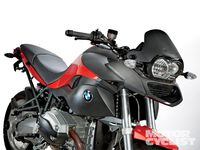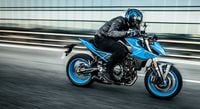Let's say you're running a high-end East Coast design house. You're a motorcycle guy who, in between talking about the golf shoe of the future and a new hands-free diaper-disposal unit, finds himself with a chunk of free time to fill. You own a BMW R1200GS, but hate the way it looks. You have a portfolio full of motorcycle concepts and hard/software capable of turning ideas into hard parts very quickly. Presto: One sinuous GS, in the flesh as it were.
That's the R1200GSM. Principal designer Andrew Serbinski and his cohorts at Machineart Industrial Design (www.machineart.com) in Frenchtown, New Jersey, ratcheted the GS idea up a few notches with a lighter, more agile-looking silhouette. "We wanted your eye to _ ow across the design," Serbinski says, "while retaining that signature toughness and versatility." Given the buzz around bikes like Ducati's Streetfighter, this swerve toward the Stra?e side is blocks ahead of Munich's latest.
Some credit goes to the Fused Deposition Modeling technology that lets designers turn ideas into actual plastic in less than a month-a fraction of the time they'd need using conventional prototyping and manufacturing methods. Plastic body parts were modeled using Alias Studio Tools and SolidWorks 3D CAD software, then manufactured using a pair of Fortus 3D Production Systems. How? Imagine an inkjet printer working in three dimensions, laying down strips of plastic via a computer controlled extrusion nozzle heated to melt the material du jour. Feed it the right CAD data and out comes your part. There's no tooling, so revisions happen in a hurry.
Though Machineart sells BMW aftermarket parts under its MachineartMoto banner, (www.machineartmoto.com) the R1200GSM is a concept with no plans for production; it's too expensive. But if you've got the money-make that a lot of money-they just might find the time.

/cloudfront-us-east-1.images.arcpublishing.com/octane/D2BDYKKNZ5GRHGDMI4PZTGRMME.jpg)

/cloudfront-us-east-1.images.arcpublishing.com/octane/UAY4WSZPOFDQRP4MCEXAKDFQOQ.jpg)

/cloudfront-us-east-1.images.arcpublishing.com/octane/X5CE3KSJHZHM5CUFGPZ7U26WB4.jpg)
/cloudfront-us-east-1.images.arcpublishing.com/octane/COWLTPGFAFGDDGJCTENYMA4VJM.jpg)
/cloudfront-us-east-1.images.arcpublishing.com/octane/H3PKUGPSUJFTND4RFPSI4OIDCE.jpg)
/cloudfront-us-east-1.images.arcpublishing.com/octane/UHGQA3MQDFCA3HLBWF7S76WH6Y.jpg)
/cloudfront-us-east-1.images.arcpublishing.com/octane/Q5EORCSTNFAVBJC4IYUHIKJTXQ.jpg)
/cloudfront-us-east-1.images.arcpublishing.com/octane/XIJ5FUFSP5A3NL7MOVZGJXAHC4.jpg)
/cloudfront-us-east-1.images.arcpublishing.com/octane/V5NZN3CGS5B5PPYFYJHIPAU5S4.jpg)
/cloudfront-us-east-1.images.arcpublishing.com/octane/CZE6ONOBU5E7HPIEEADU376C4M.jpg)
/cloudfront-us-east-1.images.arcpublishing.com/octane/UT4KL3SIYJBSPNHWJXTBE6MTGE.jpg)
/cloudfront-us-east-1.images.arcpublishing.com/octane/Q3UOIDZ22ZEVDBZUWGJXIMGJKI.jpg)
/cloudfront-us-east-1.images.arcpublishing.com/octane/YQM66WXZV5AAXNNOIUVOGVXZMY.jpg)
/cloudfront-us-east-1.images.arcpublishing.com/octane/J47NFTXNLFFGHELHZCUD2LCITA.jpg)
/cloudfront-us-east-1.images.arcpublishing.com/octane/NXPQBTLX3NCILKQ2GCFJYNIDEM.jpg)
/cloudfront-us-east-1.images.arcpublishing.com/octane/6U7NJLAYMRBZTIGNKWIA5OK2FQ.jpg)
/cloudfront-us-east-1.images.arcpublishing.com/octane/IYTZQWUROVC25IMTDEWUDQ5IQE.jpg)
/cloudfront-us-east-1.images.arcpublishing.com/octane/YJODDXEL2ZB5TENKPPN4BEYJAE.jpg)
/cloudfront-us-east-1.images.arcpublishing.com/octane/QEQQUZYNJFAIJB4DZFVFSNTCQ4.jpg)
/cloudfront-us-east-1.images.arcpublishing.com/octane/F4EEHDT3UZFKPLKVGDWMMPFEQE.jpg)
/cloudfront-us-east-1.images.arcpublishing.com/octane/J47U6OWNLBFBBG75A3ILAKFYZU.jpg)
/cloudfront-us-east-1.images.arcpublishing.com/octane/XWWQYTL3J5B7LKXDI354FFF4NQ.jpg)